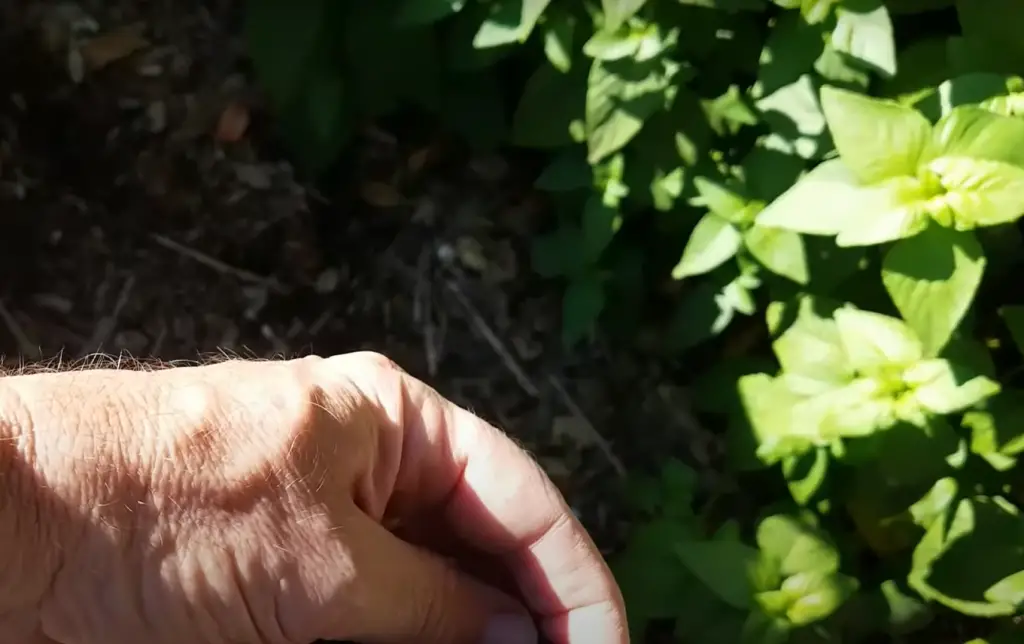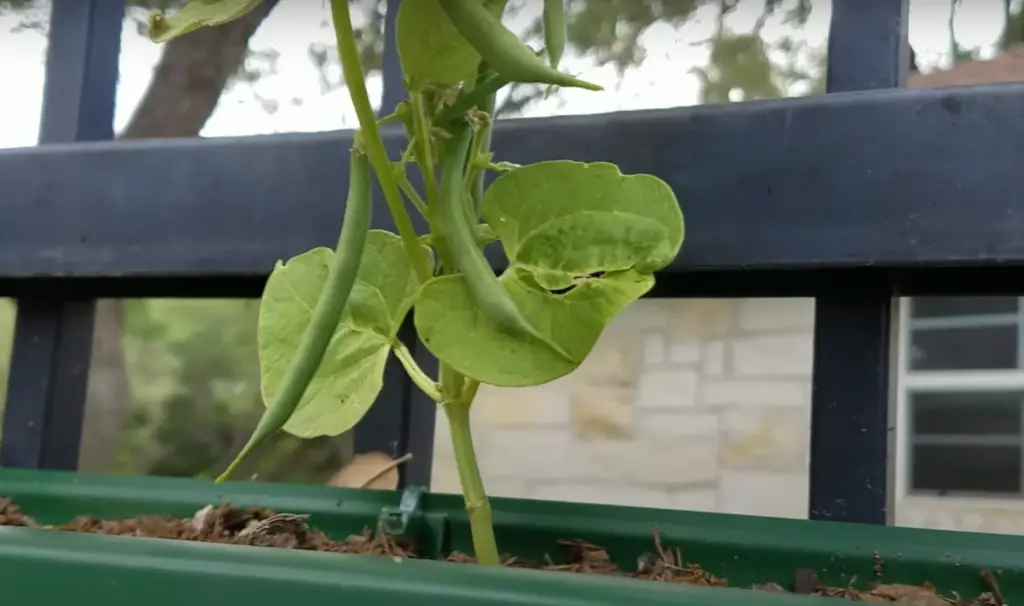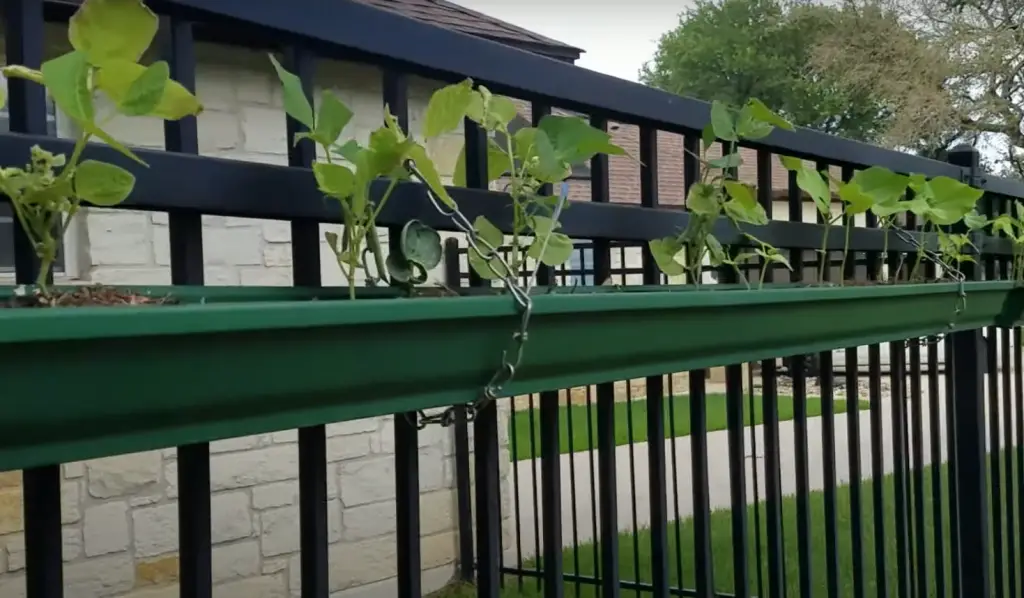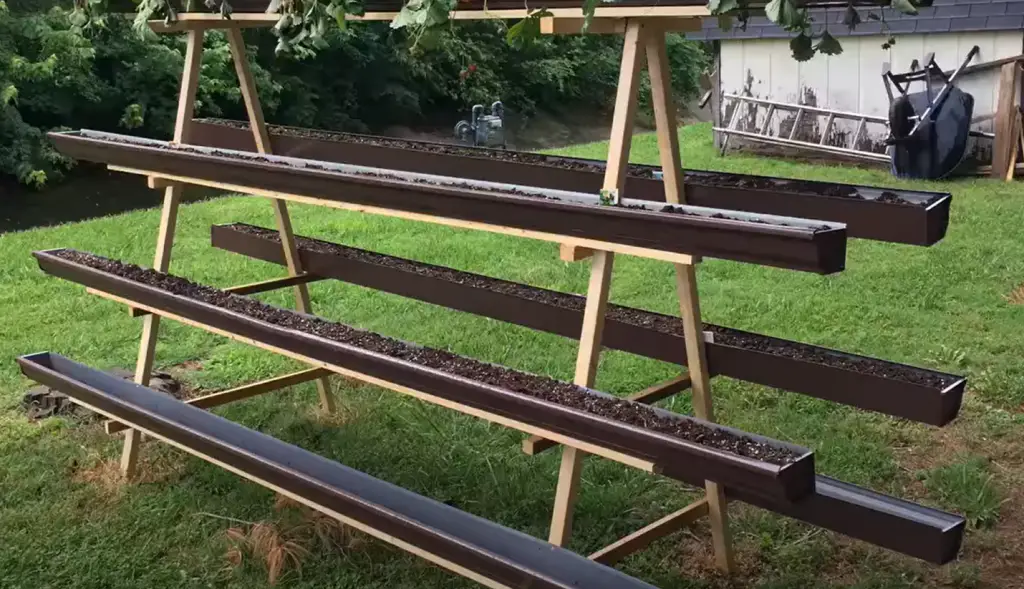Gutter gardening is an innovative way to maximize your garden space, even in the smallest of yards. By simply adding gutters to the side of your house or shed and filling them with soil, you can create a mini-garden that is both aesthetically pleasing and highly productive. With gutter gardens, you can easily grow flowers, herbs, vegetables and other plants without taking up too much space. Plus, they look great! Here are some ideas for creating a beautiful gutter garden for your home.
What’s a Gutter Garden?
A gutter garden is a vertical planter that uses gutters to hold soil and plants. It’s usually built onto the side of a house, shed or other structure.

Gutters are used as planters because they provide plenty of drainage, making them ideal for growing plants in limited space. They also look nice and can be decorated with paint, stepping stones or other decorations.
Various Types of DIY Gutter Gardens
Gutter gardens can be great for small spaces, and DIY gutter garden projects are an easy way to bring a bit of greenery into any home. Here are some types of DIY gutter gardens to get you started:
Rain Gutter Garden
Rain gutter gardens are one of the most popular types of DIY gutter gardening projects. Rain gutters can be placed horizontally or vertically on any wall and filled with soil to create a unique vertical garden. This type of garden is perfect for those who don’t have a lot of space, as it doesn’t take up much room and can be easily hung on the wall. Planting flowers and other colorful plants in a rain gutter garden will add beauty to any outdoor space.
Self-Watering Gutter Garden
For people looking for a low-maintenance garden, a self-watering gutter garden is perfect. This type of garden uses concrete gutters to hold soil and plants, so all you have to do is add water!
Cut the gutters to your desired length and use silicone caulk to seal any possible leaks. Then, fill the gutter with soil and plant your favorite flowers or vegetables. Make sure to leave enough space between the plants so they have room to grow. Once everything is in place, attach a hose or irrigation system to the gutter and you’re done! This type of garden is perfect for those who don’t have much time or experience with gardening but still want to enjoy beautiful plants. Plus, it requires very little effort on your part – just fill up the water source once in a while and watch your plants grow!Deck Gutter Garden
One of the most practical ways to create a gutter garden is to turn your deck into an oasis. Start by cutting lengths of plastic gutters long enough to fit along the sides of your deck. Attach them securely with screws and drill through the baseboards, or you can use strong adhesive like Liquid Nails.

Then fill them with soil and your favorite plants. For easy access to water, attach a hose connection to each gutter so you can keep your deck garden hydrated. With some creativity, you can also add hanging baskets or colorful planters for extra visual appeal. Enjoy the beauty of nature from the comfort of your home with this simple DIY gutter garden! [1]
Gutter Garden Ideas To Spruce Up Your Garden
Gutter gardens are a great way to add some character and color to your garden without taking up too much space.
Vertical Wall Planter
A vertical wall planter can be a great way to add some extra green around your home. All you need is a few pieces of gutter and some dirt or potting soil. You can either hang the gutter on the wall with brackets or mount it directly to the wall, depending on your preference. The plants will then grow downwards along the gutter, giving your home an interesting and unique garden look.
Over-The-Railing Planter
You can install planter boxes on your railing to make an easy and attractive gutter garden. Choose lightweight, rot-resistant wood like cedar or redwood for the box, and drill holes in the bottom for drainage. Line the planter with a plastic sheet to keep soil from falling through into your gutters. Fill it with potting soil and your favorite plants, like blooming perennials or vegetables. You can even build multiple levels of planters if you choose railing wide enough to accommodate them! To keep the boxes secure, attach eye bolts to the railing and use plant ties to fasten the boxes in place. Just make sure that you have enough space in between each box for proper drainage and air circulation.
Strawberry Planter
Strawberry planters are an excellent addition to any gutter garden. Not only do strawberries require less maintenance than other fruits, but they also produce delicious fruit every summer that can be enjoyed by the whole family. When planning your gutter garden, consider adding a strawberry planter for a delightful and low-maintenance addition.
To create a strawberry planter, simply attach your chosen container to the gutter and fill it with soil. Planting strawberries in the container will ensure that they have enough room to spread their roots and won’t be competing for space with other plants. As an added bonus, you can watch the ripening fruits from inside your home!
CISTA Rain Water Harvesting System
The CISTA Rain Water Harvesting System is a great way to make use of rain water in your gutter garden. This system collects and stores rainwater from your roof, allowing it to be used for various applications, such as watering plants or filling ponds and pools.

The system can also be connected to an irrigation system for easy access to water. The CISTA Rainwater Harvesting System is an effective way to conserve water and reduce your monthly water bills. It is also a great way to help the environment by reducing the amount of runoff that would otherwise be wasted. The system can easily be installed in residential and commercial buildings, making it perfect for anyone with a gutter garden at home. With the CISTA Rainwater Harvesting System, you can make the most out of rainwater and enjoy beautiful lush gardens all year round!
Succulents Table Planter
Create an eye-catching succulent table planter to elegantly adorn your outdoor spaces. Start by drilling several holes in the bottom of a plastic tub or container and line it with pebbles for drainage. Fill the container with potting soil and add some slow release fertilizer before planting your succulents. Arrange them in clusters to create an interesting and unique pattern. Place this planter in the shade, as succulents prefer indirect sunlight and even partial shade. Water them once a week to keep them healthy and happy. With proper care, you’ll have a beautiful gutter garden that will bring life to any outdoor space. [2]
Who Needs a Gutter Garden?
Gutter gardens are perfect for any urban dweller or suburban homeowner who is limited on traditional garden space. Whether you have no backyard to speak of, or just want to expand your current growing capacity, gutter gardens offer a great way to maximize gardening potential in small spaces. They can create an abundance of fresh produce and beautiful plants without taking up a lot of room or creating too much hassle.
Gutter gardens are also ideal for people who want to grow their own food but don’t have the time or resources to invest in traditional garden beds. With this method, you can quickly and easily create a system that can provide you with fresh herbs, fruits and vegetables without much effort. [3]
The Benefits of Gutter Gardens
Gutter gardens are an easy and cost-effective way to add greenery to your outdoor space, even in compact areas. They can be used for both decorative purposes and growing food crops such as herbs or vegetables. Additionally, gutter gardens provide several functional benefits that make them a great choice for any garden enthusiast.

One of the main benefits is that they help conserve water. The gutters are designed to direct and contain any runoff, so less water is lost due to evaporation or seepage. In addition, because the soil in gutter gardens is typically quite compact, it is more efficient at retaining moisture than traditional garden beds. This means your plants will need to be watered less often.
This makes them ideal for those with limited outdoor area or who want to maximize their garden’s impact within a smaller area.Finally, gutter gardens make it easier to get with a garden since they come in ready-to-assemble. Most include everything you need for your gutter garden, from the gutters and connecting components to soil and fertilizer. Plus, there are plenty of resources available online that provide step-by-step instructions on how to construct and maintain your own gutter garden.
Downsides to Maintaining a Gutter Garden
Despite the many advantages of having a gutter garden, there are a few downsides to consider. First, installing gutters can be expensive and time consuming. Also, if you don’t have adequate drainage in your yard, it may not be possible to install any type of garden in your gutters. Even after installation, maintaining a gutter garden can be labor intensive and requires more frequent checks to ensure the gutters are draining properly. In addition, you may need to replace your soil or fertilizer more often than with other types of gardens due to the moisture in the gutters.
For those who are willing to invest the time and money, a gutter garden can be an attractive and unique addition to your outdoor space.

With proper installation and maintenance, you can enjoy the beauty of a thriving gutter garden for years to come. [4]
FAQ
How do you build garden gutters?
Building a garden gutter is relatively simple and can be done with items easily found at most hardware stores. Start by measuring the length of your desired gutter, then purchase enough plastic or metal gutters to fit that space. Secure the gutters in place with brackets or screws, making sure they are level and securely attached. Next, drill holes in the bottom of the gutters for drainage and attach downspouts to direct water away from your house. Finally, add soil, plants or seeds to each gutter and you’re ready to go!
What do you put in a garden gutter?
If you’re looking for creative and practical ways to bring nature into your home, consider a garden gutter. Garden gutters are typically made from recycled materials such as old cans or rain gutters and can be used to create beautiful and sustainable gardens. You can use garden gutters to grow any kind of plants including flowering annuals, vegetables, and herbs. When it comes to what to put in your garden gutter, the options are nearly endless. Some popular choices include:
- Herbs like basil, oregano, rosemary, and thyme
- Lettuce or other leafy greens
- Peppers, tomatoes, and other vegetables
- Flowers like petunias, daisies, and tulips
No matter what plants you choose for your gutter garden, make sure to select ones that are well-suited for the environment. Planting in a container such as a gutter can be great because it helps to retain moisture and protects small plants from harsh temperatures. Additionally, it’s important to select plants that are not too aggressive and that will stay contained in the gutter.
How do you attach gutters to a fence?
Attaching gutters to a fence is relatively simple, provided you have the right tools and supplies. You’ll need to start by measuring your fence to determine how many gutter sections you will need and where they should be placed. Once your measurements are taken, use a drill with appropriate sized screws or bolts that are long enough to securely fasten the gutter sections in place. Make sure that all attachment points are level so that the water flows evenly throughout the entire length of the gutter system. Additionally, it may be necessary to caulk around each seam and attach corner pieces for an aesthetic look as well as providing better protection against leakage. Finally, install end caps on either side of your gutters so water doesn’t leak out of the ends. With these simple steps, your gutters will be securely attached to your fence and ready to use for catching and directing rainwater away from your home.
Why is it called a gutter?
A gutter garden is so-called because it uses a gutter as its growing medium. Gutters are shallow channels that can be attached to the side of a house or shed, and they collect water runoff from rain or other sources. The collected water is then distributed among the plants in the gutter garden, providing them with all the moisture they need to thrive. Also, the special shape of the gutter creates the perfect environment for plants to grow by trapping moisture and keeping it away from pests.
What are the three types of gutter?
Gutter gardens are a great way to add some vibrant greenery to your home without taking up too much space. But how do you know what type of gutter is best for your garden? There are three common types of gutters commonly used in gutter gardening: vinyl, aluminum, and copper. Vinyl gutters are the most economical option and offer easy installation. They require minimal maintenance and can often be painted if desired. However, they may not last as long as other materials due to their lack of strength.

Aluminum gutters are highly durable and resistant to rusting or corrosion. They also come in a variety of colors so they can easily match any outdoor decor. Aluminum gutters tend to be more expensive than vinyl but their durability makes them a great long-term solution. Copper gutters are the most visually appealing and provide a classic look to any property. They are more expensive than aluminum or vinyl and require more maintenance, as copper is prone to oxidation over time. However, copper gutters can last for many years if cared for properly.
What is a gutter design?
A gutter design is an innovative way to turn a rain gutter into a garden. It is a simple but effective way to add greenery to any outdoor space, as the plants are planted directly in the gutters. Gutter designs work by allowing water from rain or irrigation systems to be directed through the gutter, evenly distributing moisture throughout the soil and supporting healthy plant growth. This type of gardening also eliminates the need for weeding and reduces potential damage from weeds or overgrowth. Furthermore, it can help protect against soil erosion and flooding during heavy rains. Gutter gardens come in many different types and designs, so you can find one that suits your needs and fits your style best. You may choose to hang multiple gutters horizontally or vertically, and the design can be tailored to fit the size of your outdoor space.
How do gutters work?
Gutters are a valuable tool for managing rainwater and preventing flooding around the exterior of your home. They can also be used to create a unique and beautiful garden space. When attached to the edge of a roof, gutters collect water as it falls off the roof, carrying it away from your house instead of allowing it to pool up at its base. This helps protect the structure of your home against flood damage and makes gardening easier by providing a source of irrigation. Additionally, gutters provide a creative opportunity for adding plants and flowers to the exterior of your home in an unexpected way. With some simple supplies, you can transform your plain old gutter into an attractive planter that will make your outdoor living area more inviting.
What is the best gutter construction?
Gutters can be made from a variety of materials, including aluminum, vinyl, galvanized steel, copper and even wood. Each material has its own advantages and disadvantages, so it’s important to research the different options before deciding which one is best for your gutter garden project. Aluminum gutters are lightweight and easy to install, but they can corrode over time. Vinyl gutters are virtually maintenance-free and come in a variety of colors, but they tend to be less durable than other materials. Galvanized steel is strong and corrosion-resistant, making it the best choice for areas with high levels of rain or snowfall. Copper gutters offer an attractive, classic look, but they’re more expensive than other options. Finally, wooden gutters are the traditional choice for historical homes and can be used to create a unique, rustic aesthetic.
Why are gutters good?
Gutters are a great way to make use of an often overlooked and unused space in your garden. They provide a convenient way of collecting rainwater, which can then be used for watering plants or filling ponds. Gutters also help prevent soil erosion from heavy rains, preventing damage to gardens and landscaping features. Installing gutters around the perimeter of your property is an easy and economical way to boost its overall aesthetic appeal.
In addition to the practical benefits, using gutters as part of your garden design can add an interesting dynamic to your outdoor space. With creative gutter garden ideas, you can transform this functional element into something both attractive and useful. From planter boxes to hanging herb gardens, there are lots of ways you can use gutters to spruce up your garden. Here are some of the best gutter garden ideas we’ve seen.
What is a gutter and its purpose?
A gutter is a narrow channel, usually made of metal, plastic or wood that runs along the edge of your roof. Its purpose is to collect and carry away rainwater from your roof in order to prevent water damage and foundation erosion. It also helps protect walls, windows and doors from leaks. Gutters are an essential part of any home’s exterior design in order to ensure proper drainage around the house.
Useful Video:Gutter Gardening – it works, sometimes
Conclusion
Gutter gardens are a unique and creative way to bring life to your outdoor space, no matter the size. With a little bit of DIY know-how, you can create a beautiful and functional garden that is sure to be the envy of your neighbors! Whether you choose a classic gutter planter or try something more adventurous like an upcycled rain barrel, there are plenty of options when it comes to creating a personal gutter garden. There’s nothing quite like watching your favorite plants thrive with the help of some creative gutter gardening ideas! So get out there and start planning your own amazing gutter garden today!
References:
- https://gardenandhappy.com/gutter-garden-ideas/
- https://www.gardeningknowhow.com/garden-how-to/design/lideas/how-to-make-a-gutter-garden.htm
- https://afarmgirlinthemaking.com/gutter-gardening-container-garden/
- https://garden.lovetoknow.com/theme-gardens/rain-gutter-gardens










Leave a Reply
View Comments